Eutrophication is a process that occurs when excessive nutrients, mainly nitrogen and phosphorus, accumulate in a water body. This excess nutrient load can trigger excessive algae and plant growth, leading to oxygen depletion, fish kills, and a decline in water quality. Eutrophication is a significant environmental issue, affecting lakes, rivers, and coastal areas worldwide.
Causes of Eutrophication
The main cause of eutrophication is human activities. Agricultural runoff, sewage discharge, and industrial effluents are the primary sources of excess nutrients in water bodies. Fertilizers used in agriculture are a significant contributor to eutrophication. When it rains, the excess fertilizer washes into nearby rivers and lakes, increasing the nutrient load. Similarly, sewage treatment plants and industrial facilities discharge nutrient-rich water into waterways, adding to the nutrient load.
Consequences of Eutrophication
The consequences of eutrophication can be severe. The excessive growth of algae and aquatic plants can create dense mats that block sunlight, reducing the amount of oxygen in the water. This process is known as algal bloom, and it can lead to fish kills and the death of other aquatic organisms. Moreover, excessive growth of aquatic plants can clog waterways, making it difficult for boating, swimming, and other recreational activities.
Solutions to Eutrophication
To address eutrophication, we need to reduce the nutrient load entering water bodies. There are several ways to do this, including:
Reducing fertilizer use in agriculture: Farmers can adopt precision agriculture practices that reduce the amount of fertilizer needed, minimizing runoff into nearby waterways.
Upgrading sewage treatment plants: Municipalities can upgrade their wastewater treatment plants to remove excess nutrients before discharging the water.
Implementing industrial wastewater treatment: Industries can treat their wastewater before discharging it into waterways.
Restoring wetlands: Wetlands are natural filters that can remove excess nutrients from water. Restoring wetlands can help reduce the nutrient load in waterways.
Reducing urban runoff: Cities can implement green infrastructure practices that reduce the amount of stormwater runoff entering waterways.
Conclusion
Eutrophication is a significant environmental issue that can have severe consequences for aquatic ecosystems and human health. To address eutrophication, we need to reduce the nutrient load entering water bodies. Reducing fertilizer use in agriculture, upgrading sewage treatment plants, implementing industrial wastewater treatment, restoring wetlands, and reducing urban runoff are some of the ways we can reduce the nutrient load and protect our waterways. By taking action to reduce eutrophication, we can ensure that our waterways remain healthy and sustainable for generations to come.




